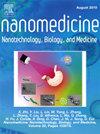用于药物递送的生物相容性窄尺寸纳米水凝胶
IF 4.6
2区 医学
Q2 MEDICINE, RESEARCH & EXPERIMENTAL
Nanomedicine : nanotechnology, biology, and medicine
Pub Date : 2025-04-23
DOI:10.1016/j.nano.2025.102824
引用次数: 0
摘要
可生物降解聚合物由于其潜在的缓释作用而引起了人们对药物控制的关注。本文开发了一系列新型的交联窄尺寸纳米水凝胶(NHGs),其尺寸可调(20-500 nm),无毒,适合多种生物应用。这些nhg是通过热响应自组装过程合成的,然后是受限聚合。在聚合物骨架中引入酯交联剂以提高生物降解性。由于NHGs在静脉给药后在血液中循环时间长,因此它是理想的药物输送候选者。成功负载了抗氧化姜黄素和抗真菌药物两性霉素B (AmB)作为疏水药物模型。与商用AmB制剂Fungizone相比,负载AmB的NHGs对霉菌和酵母菌的临床分离株具有更好的抗真菌活性,并且在接种致死剂量白色念珠菌的小鼠模型中显著降低了发病率。因此,nhg为控制药物释放提供了一个多功能平台。本文章由计算机程序翻译,如有差异,请以英文原文为准。

Biocompatible narrow size nanohydrogels for drug delivery
Biodegradable polymers have gained attention for controlled drug delivery due to their potential for sustained release. Herein, a novel series of cross-linked, narrow size nanohydrogels (NHGs) with tunable sizes (20-500 nm), devoid of toxicity, and suitable for diverse biological applications were developed. These NHGs are synthesized via a thermo-responsive self-assembly process followed by confined polymerization. Ester cross-linkers were introduced into the polymeric backbone to enhance biodegradability. The NHGs comprise ideal candidates for drug delivery due to their long circulation in blood after iv administration. The anti-oxidant curcumin and the antifungal drug amphotericin B (AmB) as hydrophobic drug models were successfully loaded. The AmB-loaded NHGs showed improved antifungal activity against clinical isolates of molds and yeasts and markedly reduced morbidity in murine models inoculated with lethal doses of the pathogenic mold Candida albicans as compared to the commercial AmB formulation Fungizone. The NHGs thereby offer a versatile platform for controlled drug release.
求助全文
通过发布文献求助,成功后即可免费获取论文全文。
去求助
来源期刊
CiteScore
11.10
自引率
0.00%
发文量
133
审稿时长
42 days
期刊介绍:
The mission of Nanomedicine: Nanotechnology, Biology, and Medicine (Nanomedicine: NBM) is to promote the emerging interdisciplinary field of nanomedicine.
Nanomedicine: NBM is an international, peer-reviewed journal presenting novel, significant, and interdisciplinary theoretical and experimental results related to nanoscience and nanotechnology in the life and health sciences. Content includes basic, translational, and clinical research addressing diagnosis, treatment, monitoring, prediction, and prevention of diseases.

 求助内容:
求助内容: 应助结果提醒方式:
应助结果提醒方式:


